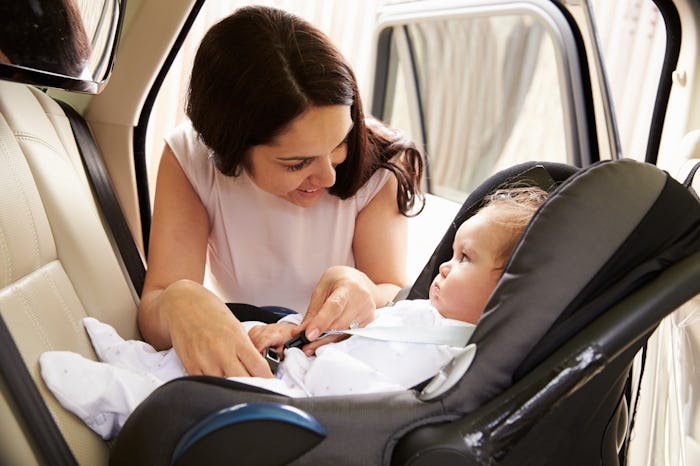Before strapping your kids into their car seats the next time you head out for an errand, you'll want to read up on the American Academy of Pediatrics' new car seat guidelines. Essentially, pediatricians are now recommending that parents keep their babies rear-facing in their car seats for "as long as possible" for increased safety.
In a new report released Thursday, Aug. 30, the AAP has recommended that infants remain rear-facing until they reach the highest weight or height allowed by the manufacturer of the seat, regardless of their age. Previous guidelines recommended that kids could face forward in their car seats after age 2. However, the academy reviews its car seat recommendations every three years and crash data ultimately led them to revise their recommendations, according to TODAY.
"Fortunately, car seat manufacturers have created seats that allow children to remain rear-facing until they weigh 40 pounds or more, which means most children can remain rear-facing past their second birthday," Dr. Benjamin Hoffman, lead author of the updated recommendations and chairperson for the AAP’s council on injury, violence, and poison protection, explained in a news release.
In the AAP's statement, it explains that with rear-facing car seats, the hard shell of the seat is immensely effective at absorbing the shock of a crash. But when a child is facing forward, even though they are well-restrained by the straps, the head can be thrown forward during an accident resulting in spine and neck injuries. This video below shows the different impact on a child’s body during a crash when their seat is rear-facing versus forward-facing. Note the small amount of force it takes — just a quarter inch of separation — to severely damage a child's spine:
The new recommendations are similar for children who ride in forward-facing seats. The AAP advises that kids stay in them until they reach the maximum height and weight recommended by the manufacturer. Belt-positioning booster seats should be used until the lap and shoulder seat belts fit a child correctly, according to the AAP. This is often when a child is between 8 to 12 years old and at least 4 feet, 9 inches. All kids younger than 13 should be restrained with seat beats in the back seat, the AAP advises.
Natasha Young — a technician for Safe Kids Worldwide and teaches parents how to install car seats correctly — spoke with CBS News' Chicago affiliate Channel 2 about what to do with a child’s legs as they grow, even if they're 2 but not quite big enough to move to forward-facing. “Even if their children’s legs are longer than the car seat, they can easily fold their legs up into the car seat and it’s actually much safer for their legs," Young explained to the news outlet.
As Dr. Hoffman pointed out in the new guidance, car seats do an excellent job of protecting children in the event of a crash, but that also means there is little data on when it is safest to turn a car seat around. As he noted in the AAP's statement:
If you have a choice, keeping your child rear-facing as long as possible is the best way to keep them safe.
Auto accidents are the leading cause of death for children 4 and older, according to the AAP. Dr. Hoffman went on to advise that the most important thing is to be consistent when traveling with kids; using a car seat or booster seat correctly for every trip can reduce the risk of injury or death by up to 70 percent, as the AAP noted.
All parents will agree that children's safety is of the utmost importance and having these updated recommendations help moms and dads ensure they're doing everything they can to keep their little ones safe on the road.
